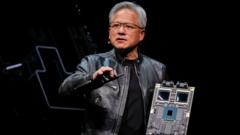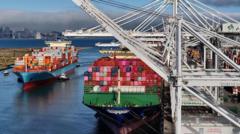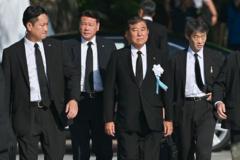China's naval capabilities are on display as two aircraft carriers venture into the Pacific, highlighting the growing military tension in the region.
China Expands Naval Power: Two Aircraft Carriers Enter Pacific Waters

China Expands Naval Power: Two Aircraft Carriers Enter Pacific Waters
Beijing's military demonstration marks a significant shift in naval strategy, sending its aircraft carriers into the Pacific for the first time.
In a significant showcase of military prowess, the Chinese Navy has for the first time dispatched two aircraft carriers into the Pacific Ocean. This maneuver not only signifies a bold advancement in China's naval capabilities but also raises alarms about strategic shifts in regional power balance. Japan's Defense Minister, Gen Nakatani, confirmed that these operations involved the Liaoning and Shandong carriers, which were observed conducting flight operations east of Iwo Jima, approximately 750 miles from Tokyo.
The drills began on a Saturday and represent the first coordinated exercise of both carriers beyond Japan's territorial waters, effectively breaching what Beijing refers to as the First Island Chain — a strategic barrier encompassing Japan and other nearby islands. Analysts believe that deploying these vessels beyond traditional boundaries allows China to display its potential power projection, indicating its readiness to challenge both Japan and the United States in any regional crisis.
This naval demonstration unfolds at a precarious moment, as tensions over Taiwan continue to simmer. The self-governing island, viewed by Beijing as part of its territory, has become a focal point for potential military conflict, with the U.S. committing to defend Taiwan in the event of an aggression.
While China’s naval fleet has expanded, featuring a third aircraft carrier currently in trials and a fourth undergoing construction, it still lags behind the U.S. fleet, which boasts eleven large nuclear-powered carriers. In response to the evolving threats, Japan has initiated plans to build its own small carriers capable of accommodating advanced F-35B stealth fighters, marking its return to aircraft carrier capabilities since World War II.
With these developments, maritime security in the western Pacific remains uncertain as both nations recalibrate their strategies and reaffirm their military readiness.
The drills began on a Saturday and represent the first coordinated exercise of both carriers beyond Japan's territorial waters, effectively breaching what Beijing refers to as the First Island Chain — a strategic barrier encompassing Japan and other nearby islands. Analysts believe that deploying these vessels beyond traditional boundaries allows China to display its potential power projection, indicating its readiness to challenge both Japan and the United States in any regional crisis.
This naval demonstration unfolds at a precarious moment, as tensions over Taiwan continue to simmer. The self-governing island, viewed by Beijing as part of its territory, has become a focal point for potential military conflict, with the U.S. committing to defend Taiwan in the event of an aggression.
While China’s naval fleet has expanded, featuring a third aircraft carrier currently in trials and a fourth undergoing construction, it still lags behind the U.S. fleet, which boasts eleven large nuclear-powered carriers. In response to the evolving threats, Japan has initiated plans to build its own small carriers capable of accommodating advanced F-35B stealth fighters, marking its return to aircraft carrier capabilities since World War II.
With these developments, maritime security in the western Pacific remains uncertain as both nations recalibrate their strategies and reaffirm their military readiness.

















